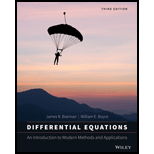
Concept explainers
Suppose that a certain population satisfies the initial value problem
Where the growth rate
Suppose that
Estimate the critical initial population
Choose other values of
Use the data you have found in parts (a), (b) and (c) to plot
Want to see the full answer?
Check out a sample textbook solution
Chapter 2 Solutions
Differential Equations: An Introduction to Modern Methods and Applications
Additional Math Textbook Solutions
A Problem Solving Approach To Mathematics For Elementary School Teachers (13th Edition)
Introductory Statistics
Calculus: Early Transcendentals (2nd Edition)
University Calculus: Early Transcendentals (4th Edition)
College Algebra (7th Edition)
- I circled the correct, could you explain using stokearrow_forwardFemale Male Totals Less than High School Diploma 0.077 0.110 0.187 High School Diploma 0.154 0.201 0.355 Some College/University 0.141 0.129 0.270 College/University Graduate 0.092 0.096 0.188 Totals 0.464 0.536 1.000arrow_forwardFemale Male Totals Less than High School Diploma 0.077 0.110 0.187 High School Diploma 0.154 0.201 0.355 Some College/University 0.141 0.129 0.270 College/University Graduate 0.092 0.096 0.188 Totals 0.464 0.536 1.000arrow_forward
- Female Male Totals Less than High School Diploma 0.077 0.110 0.187 High School Diploma 0.154 0.201 0.355 Some College/University 0.141 0.129 0.270 College/University Graduate 0.092 0.096 0.188 Totals 0.464 0.536 1.000arrow_forwardFemale Male Totals Less than High School Diploma 0.077 0.110 0.187 High School Diploma 0.154 0.201 0.355 Some College/University 0.141 0.129 0.270 College/University Graduate 0.092 0.096 0.188 Totals 0.464 0.536 1.000arrow_forwardUse Euler's method to numerically integrate dy dx -2x+12x² - 20x +8.5 from x=0 to x=4 with a step size of 0.5. The initial condition at x=0 is y=1. Recall that the exact solution is given by y = -0.5x+4x³- 10x² + 8.5x+1arrow_forward
- Find an equation of the line tangent to the graph of f(x) = (5x-9)(x+4) at (2,6).arrow_forwardFind the point on the graph of the given function at which the slope of the tangent line is the given slope. 2 f(x)=8x²+4x-7; slope of the tangent line = -3arrow_forwardUse the product rule to find the derivative of the following. p(y) (y¹ + y²) (6y¯³-10y¯4)arrow_forward
- What is the area of this figure? 22 mm 5 mm 3 mm 3 mm 7 mm 4 mm Write your answer using decimals. Use 3.14 for л. Submit square millimetersarrow_forwardSuppose you know that Bob's test score is above the mean, but he doesn't remember by how much. At least how many students must score lower than Bob?arrow_forwardIf 0 = 0 = 10元 3 10元 then find exact values for the following. If the trigonometric function is undefined fo enter DNE. > 3 sec(0) equals csc(0) equals tan(0) equals cot (0) equals من Question Help: Video B من B Submit Question Jump to Answerarrow_forward
- Algebra & Trigonometry with Analytic GeometryAlgebraISBN:9781133382119Author:SwokowskiPublisher:Cengage
 Linear Algebra: A Modern IntroductionAlgebraISBN:9781285463247Author:David PoolePublisher:Cengage Learning
Linear Algebra: A Modern IntroductionAlgebraISBN:9781285463247Author:David PoolePublisher:Cengage Learning


